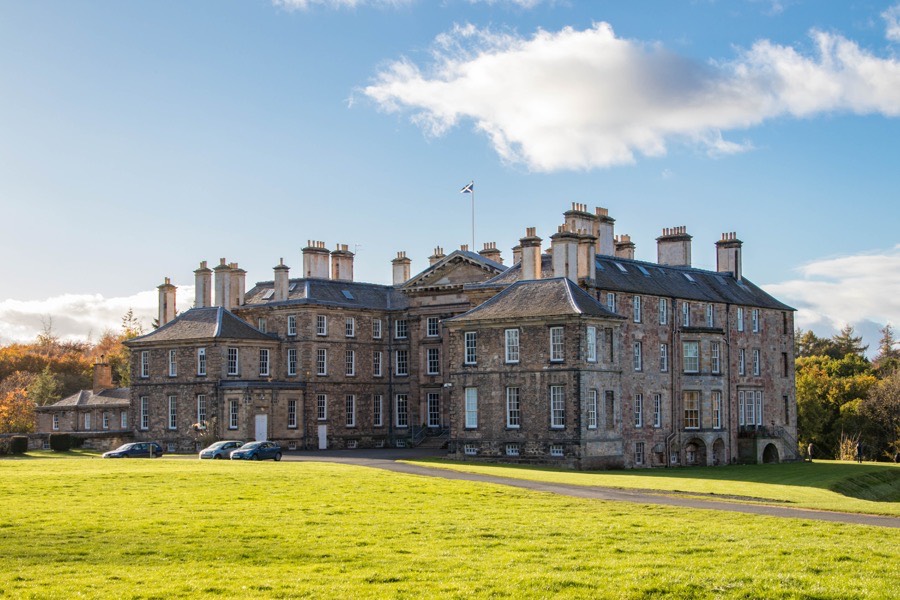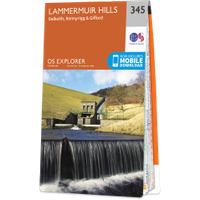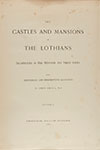

Dalkeith Palace is a largely 18th century mansion which incorporates parts of an older tower house.
The earliest castle at Dalkeith was built in the 12th century and was owned by the de Grahame family. The castle stood on the edge of a high promontory above a curve in the River North Esk, offering considerable defensive protection to the south, north and west.


In 1342 Sir John de Grahame of Dalkeith resigned the barony of Dalkeith to his son-in-law, Sir William Douglas of Kincavil, Lord of Hermiston, who was married to Sir John’s daughter, Margaret or Marjory.
Sir William, who was known as the Knight of Liddesdale, granted the barony of Dalkeith to his nephew, Sir James Douglas, who became known as Sir James Douglas of Dalkeith and the 1st Lord Dalkeith. Sir James died in 1420 and was succeeded by his son, also Sir James, who with his wife, Elizabeth, had five children. The eldest, William, died in 1425 and so upon the death of Sir James in 1441 he was succeeded by his second son, James, as 3rd Lord Dalkeith. However the 2nd Lord Dalkeith, who was married to Elizabeth Gifford, daughter of James Gifford of Sheriffhall, was deemed incapable of managing his own affairs and his brother-in-law, also named James Gifford of Sheriffhall, was appointed to administer his estates.
In 1456 the 3rd Lord Dalkeith resigned his lands to his son, James Douglas, 4th Lord Dalkeith, who in 1458 was raised to the peerage as 1st Earl of Morton upon his marriage to Joan Stewart, daughter of James I.
The castle was added to in the 15th century, forming an L-plan keep with a curtain wall. In 1548 James Douglas, 4th Earl of Morton, was captured by the English while defending Dalkeith Palace against them and taken to England as a hostage, being released in 1550.
Morton became Lord Chancellor of Scotland in 1563 and Mary, Queen of Scots, confirmed the Earl of Morton’s various lands including the lands and barony of Lintoun in the same year. In 1566 he led the armed force which entered Holyroodhouse to murder David Rizzio and in 1567 was involved in obtaining Mary’s consent for her abdication while she was imprisoned in Lochleven Castle.
In 1568 Morton led the vanguard of the army which defeated Mary’s supporters at the Battle of Langside and in 1572 he became Regent to the infant James VI. In the 1570s the castle and associated palace were greatly enlarged for the 4th Earl of Morton. Morton’s power and influence wained when James VI was declared an adult ruler in 1578, and he retired to Lochleven Castle for a while.
Morton was arrested in 1580 having been accused of complicity in Lord Darnley’s murder in 1567, was attainted and executed in 1581.
The Douglas family sold Dalkeith Palace to Francis, the 2nd Earl of Buccleuch, in 1642.
A view of the castle drawn by John Slezer around 1690, wrongly titled Glamms House (Glamis Castle), shows an L-plan tower at the far end of a courtyard lined with ranges of buildings. A tall gatehouse leads into an outer courtyard on the opposite side of which is another tall gatehouse with a curtain wall to its left and a four storey range to its right.
Between 1702 and 1710 the palace was extensively remodelled for Anne, the Duchess of Buccleuch, with part of the existing castle demolished and the rest, including some of the vaulted ceilings, incorporated into the new Dalkeith House. Some of the old tower’s walls are said to be recognisable on the western façade of its successor.

The new house was designed by James Smith, and was later added to over the years by the celebrated Scottish architects John Adam, James Playfair and William Burn.

It is now a European study centre for the University of Wisconsin and the centrepiece of the Dalkeith Country Estate.
Alternative names for Dalkeith Palace
Dalkeith Castle; Dalkeith House














